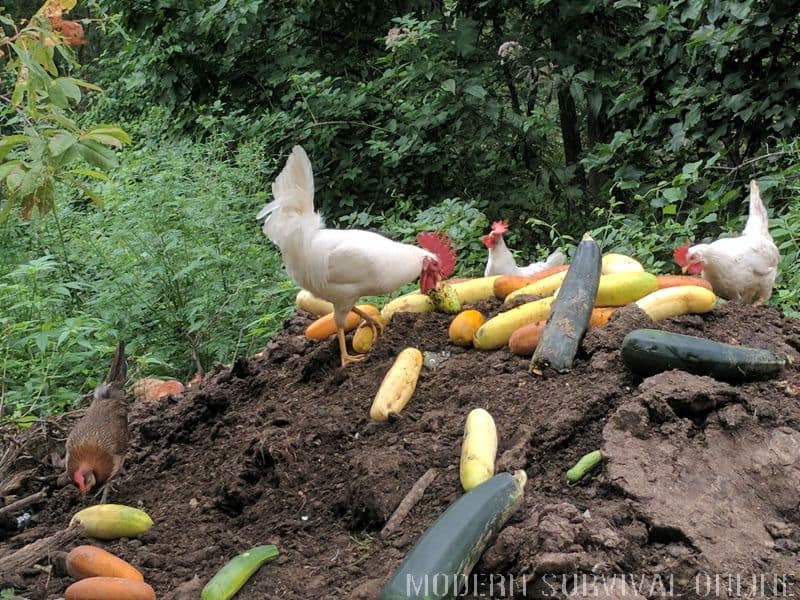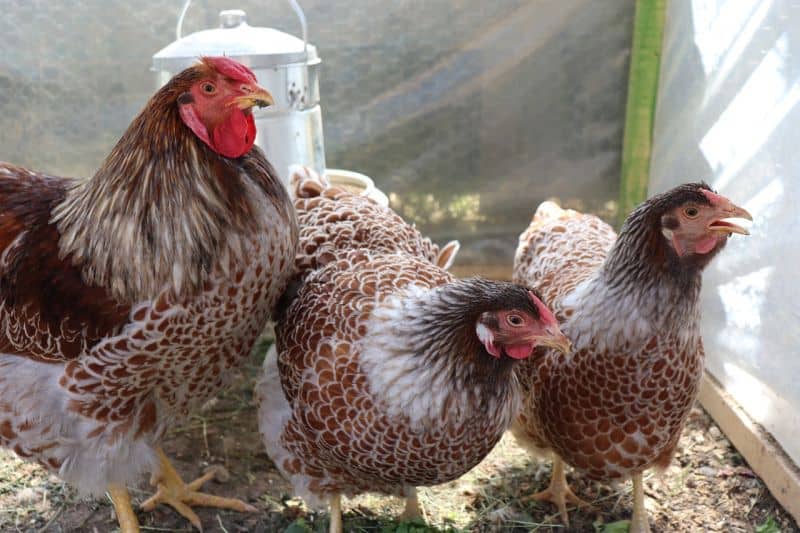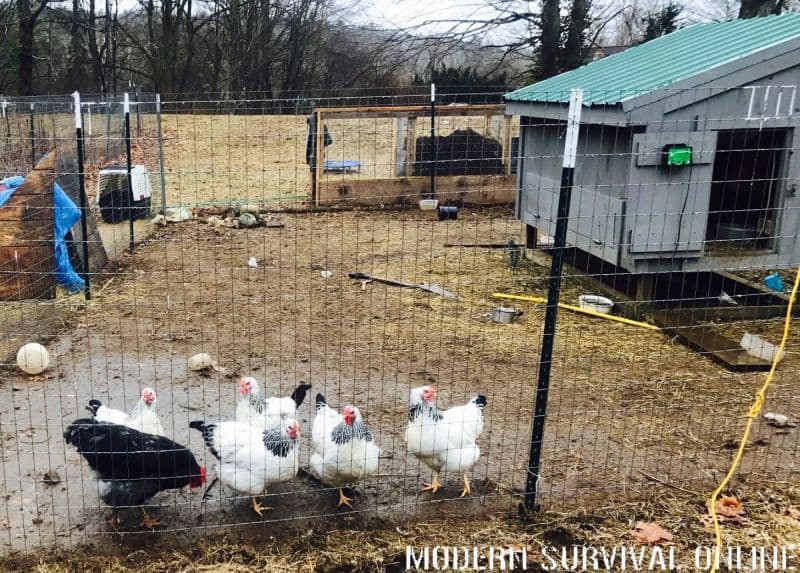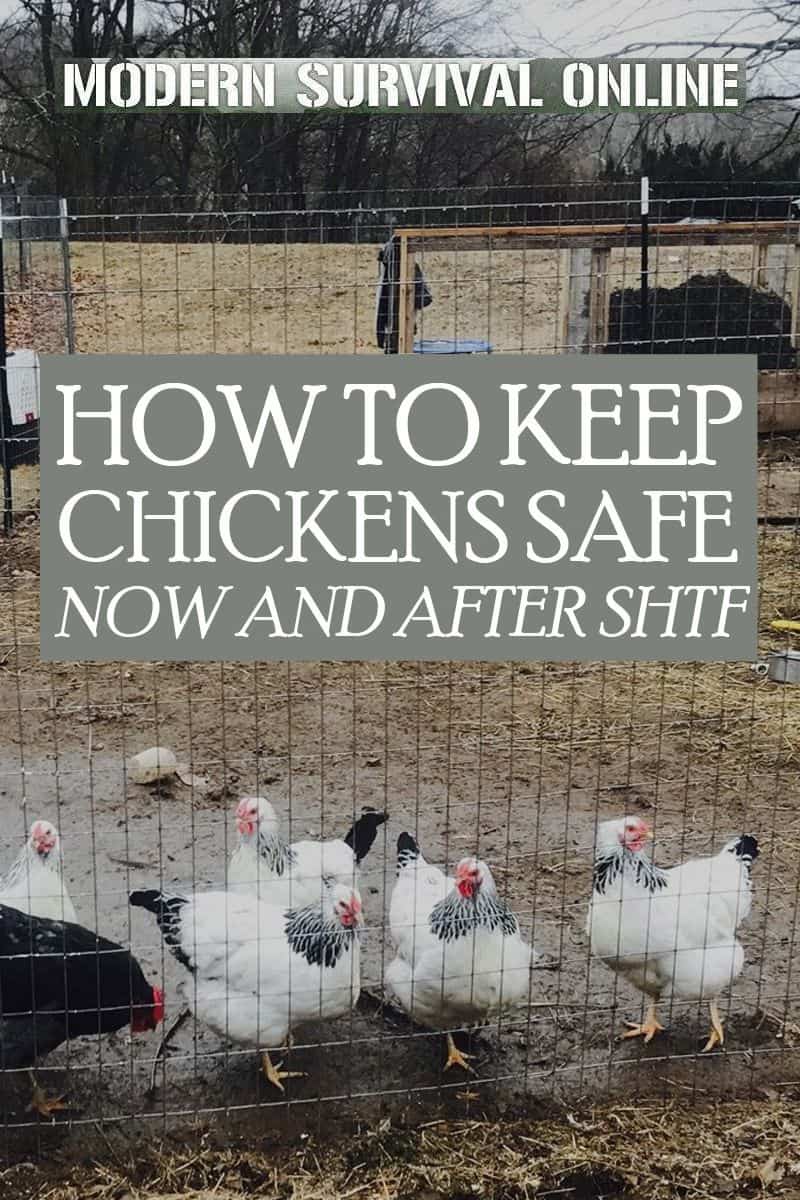Keeping a flock of chickens safe and healthy to ensure they will be around to provide meat and eggs can seem like a challenging task on a daily basis now, before the SHTF.
Once a doomsday disaster strikes, keeping the chickens safe becomes a life necessity. It doesn’t take a lot of money to protect the flock, but doing so will demand planning, manual labor, and regular checks on the coop and run.

Chickens will be an incredibly valuable asset during a SHTF scenario. Wise preppers already know this, and are creating large and sustainable flocks are part of their survival food plan.
Poultry birds are one of the best types of survival livestock a prepper could keep. They are inexpensive to both buy, feed, enclose, take up little space, and provide a steady supply of meat and eggs. Butchering a chicken does not require costly tools or heavy lifting.
Keeping a live food supply safe is not a new concept in America, merely one that has been nearly forgotten during our modern times.
During the Great Depression families across the country had to survive largely on the food they could grow and raise themselves because they had no money to buy items from a local store.
Developing and putting into practice chicken husbandry habits now, that will also keep the birds safe not just today, but during a SHTF event. Getting the birds and the keepers used to a routine is a vital part of the safety and security process.
Not only will you be able to cross train others in all aspects of chicken husbandry from the hatching of chicks all the way up through butchering and preserving the birds, but can afford the time to work out any kinks in your plan – now, when adapting it is still feasible.
Revamping Old-Fashioned Chicken Keeping Tactics
Our grandparents and great grandparents knew that both two and four legged predators would be eager to snag a free meal or eggs that they could otherwise sell to buy other wanted items.
The same scenario will play out during a SHTF event – but probably during a WROL situation.
OPSEC
The essential part of maximizing the benefits of chicken keeping while minimizing losses involves not only keeping the flock in a safe and clean pen, but keeping them hidden from being viewed or heard by others.
OPSEC is the vital first step is not done properly, everyone passing by will know that you are keeping a food source all to yourself while the unprepared masses are starving. Get this part wrong, and you won’t be a chicken keeper for long.
Practicing both sight and sound discipline will help prevent others from detecting your growing food source.
If you live in a small town, do not buy your livestock feed locally. I feel horribly typing that, I try very hard to support the few businesses we have in our rural county.
But, if you buy locally in a small town everyone who works at the store and frequent customers you chat with while shopping will known – and remember, that you keep livestock.
In my area, most folks keep animals and have gardens, but most does not mean all. There will be hungry and panicked people just three days into a SHTF event.
You do not want scared, hungry, and armed masses of people showing up at your place because they frequently saw you buying livestock feed at the local store.
Do not share photos of your livestock on Facebook. Far too often folks post images of their cute new chicks, lambs, baby goats, and calves.
The people in your community that see those images will know where to come after grocery store shelves run empty – which we all know will take only hours.
The chicken coop should be placed as close to the house as possible, preferably downwind. Even if you do not visit the coop daily, it should be built near the home with an extremely spacious run (more on that below) and room for the flock to grow.
The closer the poultry birds are to the home, the better they are protected from both humans and animal predators.
Don’t forget to build a brooder – or several, for keeping a momma hen and her chicks until they are old enough to be filtered into the larger flock.
A smaller and more portable brooder should be built for housing chicks indoors due to inclement weather after late fall or early spring hatchings. Even if you cannot run brooder heat lamps, the chicks will have a far better survival rate inside where it is not frigidly cold.
Rooster Crowing
You must view keeping the poultry birds a secret just as strongly and as diligently as you do you stockpile of weapons and ammo. Purchasing a quiet breed of chickens is a great first step but all … ALL roosters crow.
In a survival chicken flock, you must keep a minimum of two roosters at all times – one is none and two is one – as the prepping mantra goes.
If one rooster dies you will have to wait and hope that a cockerel chick reaches maturity and furthers flock numbers before your family is forced to consume all the available eggs and birds.
Purchase multiple no-crow rooster collars as a part of your food security survival plan.
Preventing a rooster from doing what comes natural seems cruel, and it may very well be even though the collar does not physically harm the rooster – but, keeping the bird as quiet as possible increases the chances that you children will not go hungry.
Remember, sound carries, especially during the winter months that there are no leaves on the trees and the forest brush has died back.
We live literally in the middle of the woods on a 56-acre survival homestead and I still would want no-crow collars on our roosters during a SHTF situation.
It is not uncommon to hear the sounds of our nearest neighbors, who live across the road from the start of our half-mile private farm road, during the winter months.

Quiet Chicken Breeds
Hens clatter, sometimes loudly. Keeping the ladies quiet will not be as difficult as taming back the loud noise of a crowing rooster, but to help prevent all of the clucking of the hens from being herd, consider purchasing one of the top five quiet chicken breeds.
Roosters in these breeds tend to be quieter than those of other varieties, but make no mistake about it, fellow preppers, they will still crow… and not just at dawn.
- Rhode Island Reds – These chickens are known to be docile, quiet, cold weather hardy, and layers of superbly large brown eggs. The only downside to keeping Rhode Island Reds is their poor sitting abilities. To better your chances of being able to hatch chicken eggs naturally, also purchase some Bantam hens. These little hens lay nice small white eggs year round, and are dedicated mommas that are eager to adopt the eggs of other hens that are not doing their jobs properly. They are also a laid back and quieter breed of chicken.
- Buff Orpingtons – These stately looking poultry birds are not only a quiet and hardy breed, their roosters are known to be among the most docile, as well.
- Barred Rock Plymouth – Chicken of this breed are quiet, great free rangers, boast some of the most docile roosters, and lay medium to large brown eggs.
- Wyandottes – The hens from this breed are excellent layers and fairly good sitters. Wyandottes are hardy in nearly all climates and while not affectionate with their keepers, tend to be easy to handle. They are known as a dual purpose meat and egg bird.
- Ameraucanas – This is another dual purpose and quiet chicken breed. Ameraucanas grow to reach seven pounds, lay medium white eggs in substantial quantities, and are good free rangers.

Building A Stealth Coop And Run
Spend both the money and the time to build the “Fort Knox” of chicken coops and runs. This cannot be stated firmly enough, spend the money now so that you and your family can eat later.
Do not use chicken wire on the coop or run in any way, shape, or form. Chicken wire is good for keeping chickens in but will NOT keep predators out. The wire is too thin and gives too easily to prevent raccoons, mink, opossums, weasels, or snakes out.
Hardware cloth, also known as rabbit hutch wire, should be used on the chicken run from top to bottom.
- Dig one foot down around the perimeter of the entire chicken run.
- Lay at least one layer of hardware cloth down so it runs through from one side of the run to the next other – from the back of the run where the birds enter from the coop to the front.
- Cover the hardware cloth with ample dirt so it is no longer visible.
- Use pressure treated 4 X 4 or pressure treated 2 by 4 boards to build a frame on top of the hardware cloth of the perimeter – make sure to leave enough excess on the bottom run chicken wire layer so that it can be pulled up and around the board and stapled firmly into place.
- From here, use pressure treated wood posts or T posts on all four corners of the chicken run and spaced no further than three feet apart along the side of the chicken run.
- Use hardware cloth stapled or wired to these supports and to the bottom pressure treated boards to frame out the chicken run.
- The top of the run should also be made of chicken wire. Adding a wood or metal roof over part of the chicken run to protect the birds from getting too much sun and to allow them an outdoor space to room when it is raining or snowing is highly recommended.
You do not want the birds spending too much time indoors and walking around in their droppings – doing so not only makes more mess for you to clean but can also cause and spread disease.
Some poultry diseases can wipe out an entire flock in mere days. Keeping poultry birds in multiple coops to prevent the loss of an entire flock from a contagious disease is also a wise idea.
Predators will not be able to dig through hardware cloth. It can rust and weaken to the point that it is no longer predator proof over time, but this will take at least three years to occur.
Purchase enough extra hardware cloth and keep it stored indoors so the coop (and run) can be repaired as needed.
Stealth Chicken Coop
The coop itself should be placed directly on unprotected ground. This will make the birds far too vulnerable to digging and clawing predators.
- To better protect the chicken flock, attach thick metal sheeting to pressure treated boards to make a base plate.
- Cover the boards with two sheets of hardware cloth.
- Cover the hardware cloth layer with another layer of pressure-treated boards.
- For ease of cleaning, covering the top layer of boards at the base of the chicken coop with thick rubber will allow you to use buckets or water or a water hose to clean the bird waste easier.
All of the doors and flaps on the chicken coop should have at least one two step lock to secure them closed.
A raccoon can open a one step lock in only a few minutes when determined to find a meal. Using latches that can have a lock applied to them is also a good idea.
A human with an axe or wire cutters will still be able to get inside the coop, but doing so will take a while and cause a bit of noise… a lot of noise if the flock becomes startled and starts carrying on in fright.
Do not use a dusk to dawn automatic door on the chicken coop. A clever human can hold a flashlight up to the sensor and free the birds at night, making them more accessible to theft when they venture into the run.
To further protect the chicken coop and run and the poultry birds that live there, add solar motion detector lights to all sides of the coop.
Action motivated predator decoys – plastic owls that can be attached to the coop or run, etc. also can help deter two and four legged predators and alert you to the threat.
Many chicken keepers also raise guineas. They are the junkyard dog of the poultry world. They will fight animals far larger and more vicious than themselves to protect “their” flock.
When anything, anyone, or any animal is in an area it does not belong in, they will shriek loudly and frequently to let you know.
Now, both the predator decoys and the guineas are not OPSEC friendly. Only you can decide how to balance the need for secrecy with the desire to be alerted if a predator of any type of getting near your birds.
Flock Growth
Do not neglect to factor the growth of the flock into your chicken coop and run plans. You will want to raise as many birds as you can feed during a SHTF situation.
Adding ample space inside both structures, along with enough roosting areas and nesting boxes for the birds, is in a prepper’s best interest.
Overcrowding the coop and run will cause fighting and potentially injuries of the birds and vastly increases the possibility of disease spread as well as trampled and cracked eggs.
Place several hanging solar coop lights (a cord runs to the outside of the coop with the sun sensor) will help the birds achieve the 8 to 10 hours of sunlight they need to lay eggs during the short days of winter.
The lights also invite the birds to spend more time indoors when the temperature drops, staying too long outdoors to be exposed to light can cause you to lose birds to frostbite.
Chicken Longevity and Sustainability
Keeping the chicken flock safe means keeping them alive. Keeping the birds alive will require providing them with all the clean water and healthy food they need to survive.
Stockpiling chicken feed and straw is only one step in making the chicken coop a sustainable place to live.
Dig a shallow pond, or sink a plastic baby pool in the chicken run as well as setting up a rainwater collection system on the coop to help collect and store free water.
The pond option is a lot better than the baby pool due to not only the cleaning needs of the pool, but also out of concern that young birds will get into the water when the level drops below a side perching level, and drowns.
Create a composting pile in one corner of the chicken run so the birds can help you develop quality dirt for the survival garden, and you have a place to put any food scraps you may have so the birds can eat them and the bugs they attract.
Growing food in planters next to the chicken coop so they can easily be moved inside to feed the birds should also be a part of the poultry bird sustainability plan.
Micro sprouts grow quickly even indoors under normal room lights, and can be used to help supplement the nutrient intake of the flock during the winter months.
Planting a berry bush and Jerusalem artichoke plants inside the run will keep a growing supply of food for the chickens to eat.
Planting millet in a raised garden bed to cut and toss into the run for the birds to eat as a nutrient supplement, will also keep them fed after commercially manufactured chicken feed runs out.
Save your eggshells for the flock. By crushing them up and feeding them back to the flock you are infusing more calcium into their diets and will help them lay stronger and thicker eggs.
Some folks staunchly believe hens should only be fed their own eggs for fear or spreading disease.
I have never been fussy about which hens gets which eggs because I diligently do health checks on my birds during daily livestock chores, and have never had a problem with a transfer of birds germs – but your experience could differ.
Chicken Tractors
Building or buying a chicken tractor is a must for feeding the flock during a SHTF event. The flock can be moved about in the tractor so they can safely forage for their own food.
The chicken tractor browsing for food daily activity alone could keep your flock alive when their purchased feed runs out – depending upon the size of your prepper retreat.
Ample free chicken tractor plans exist online, including ones created with wheelbarrow style handles that makes it more closely resemble a rickshaw – designed to be easily pulled or pushed by humans.
I free range my poultry flocks now. They, along with my ducks that share quarters with the chickens, are trained to walk back into the run on their own before dusk to get a treat and locked up for the night.
This habit will be really risky during a SHTF event – supervised browsing for food only or a chicken tractor offer a far safer option.
Boredom Busters
Once you have built the Fort Knox of chicken coops and runs, and have taken steps to fulfill the sustainable food need of the poultry birds, it is time to turn your attention to boredom busters.
I can guarantee you that the birds will not care that the SHTF, they will still want to find ways to enjoy their day – and you will need them too.
A bored bird can not only get aggressive with other flock members, but start the bad habits of plucking out its own feathers, or try to peck its way out of the coop or run.
If you free ranged your birds before the SHTF, they will be used to a lot more freedom of movement than they will receive when kept inside of a run day and night, eagerly awaiting their turn in the chicken tractor.
Place tires with dirt, sand, or cooled wood ash inside the chicken run so the hens can take dirt baths. This is not only a social activity for the hens but it also helps rid them of parasites.
Adding several perches, swings, and natural items the birds can climb upon will also keep them physically active and mentally stimulated so they do not get bored and act out.
If you live in a small town, city, or the suburbs and want to safely keep chickens during a SHTF event the best piece of advice I can offer is – move. There are a plethora of reasons preppers are better off in a rural area, and the covert keeping of livestock is chief among them.
Trying to prevent neighbors from seeing or hearing a flock of chickens, even a small flock that includes a single rooster will likely make too much noise to adhere to the OPSEC guidelines you will need to follow to prevent the loss of the flock to the unprepared.
If they come for your birds, odds are pretty good that they might be leaving with a lot more of your preps…

via Modern Survival Online https://ift.tt/3ieAinp
No comments:
Post a Comment